To the West and South of Parkend there was an extensive network of privately owned narrow gauge tramways that were not part of the Severn and Wye owned system. These were known as the Dike’s and Oakwood Tramways.

In later years the Severn and Wye Joint Railway provided transhipment facilities at the Parkend wharf. The feeder tramway was the Oakwood tramway. Confusedly, the Oakwood branch of the Severn and Wye left the main line at Tufts junction south of Whitecroft, and followed the route of the Dike’s tramway as far as Princess Royal Colliery at Whitecroft/Bream.
Both Flour Mill and Princess Royal Collieries were served by this system, as were a whole series of quarries, ironworks and chemical factories. It is difficult to credit how extensive this system was when visiting the area today. The two tramways are marked in pink and blue on the 1880s OS Map above. The Oakwood Branch of the Severn and Wye Railway can just be picked out in the bottom right of the map excerpt.
The transhipment wharves at the North East end of the system, at Parkend, remained in use until the late 20th Century and were used to transfer lorry loads to railway wagons long after the Oakwood Tramway was abandoned.
Parkend
Parkend had quite a concentration of tramways associated with local collieries and iron works as well as hosting the terminus of the Oakwood Tramway at Marsh Sidings. The extract from the 1880s OS Map shows them clearly.
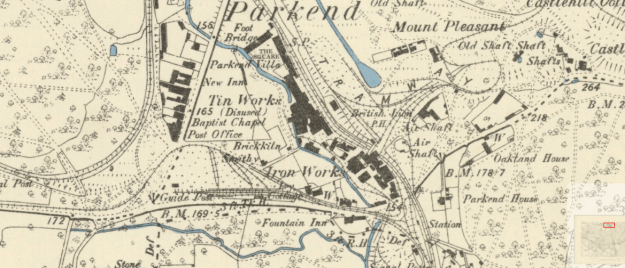
Prior to the construction of the Severn and Wye railway, the Oakwood Tramway connected directly to the Severn and Wye Tramway just to the south of the location of Parkend Station.
Parkend dates back to the early 17th century. During the 19th century it was a busy industrial village with several coalmines, an ironworks, stoneworks, timber-yard and a tinplate works, but by the early 20th century most had succumbed to a loss of markets and the general industrial decline.
More about Parkend can be found at: http://wp.me/p45mBO-zI
Marsh Sidings, Parkend
Marsh Sidings are clearly visible on the left in the sketch below, which can be found on the Deanweb Parkend page. Like many of the other transhipment wharves in the Forest, tramway wagons arrived on rails set at a higher level that the railway tracks making it easier to transfer a load either by hand or by tipping the tramway wagon.

Route to the Flour Mill Colliery
From Marsh Sidings the tramway followed the Coleford road out of Parkend until it reached the end of Whitemead Park. At this point the Coleford road separated from the road to Bream.
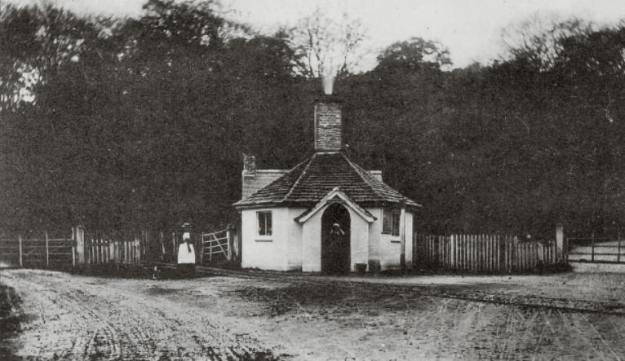
This picture of the turnpike cottage was taken in 1888. Crossing the Coleford road, and to the right of the Bream road which was constructed by the Turnpike Trust in the early 1820s, is the narrow-gauge Oakwood tramway built by David Mushet in 1826. In the length that runs parallel with the Bream road, many of the track’s foundation stones are still visible today.
The tramway followed the route of the turnpike road to Bream, hugging its western side until the road diverted marginally to the south to pass through Knockley Quarries. Tramway continued generally on a South-south-westerly path in the valley below the quarries. South of the quarries the tramway turned more to the south-east generally following the turnpike road before turning sharply back to the southwest to approach the Flour Mill Colliery.
The Flour Mill Colliery
Today, one of the Flour Mill Colliery buildings is still in use as ‘The Flour Mill Ltd’. The company is engaged principally in the repair and overhaul of steam locomotives, although it undertakes other railway-related activities such as the valuation of historic locomotives and luxury train operations. Owned and managed by William Parker, who had previously kept working engineering alive at Swindon after British Rail Engineering Ltd closed, the business occupies a workshop converted from a historically-listed colliery electricity generating station.
The colliery was known as the Flour Mill, presumably because the way to it from the village of Bream passed the Oakwood water mill. There is no evidence of a flour mill ever being on the site, and no known association with flour or milling. However the colliery was at one time the largest employer in Bream, and most families originating from the village have one or more relative or ancestor who worked there. For more on the Colliery please see … https://rogerfarnworth.wordpress.com/2017/09/30/the-flour-mill-colliery
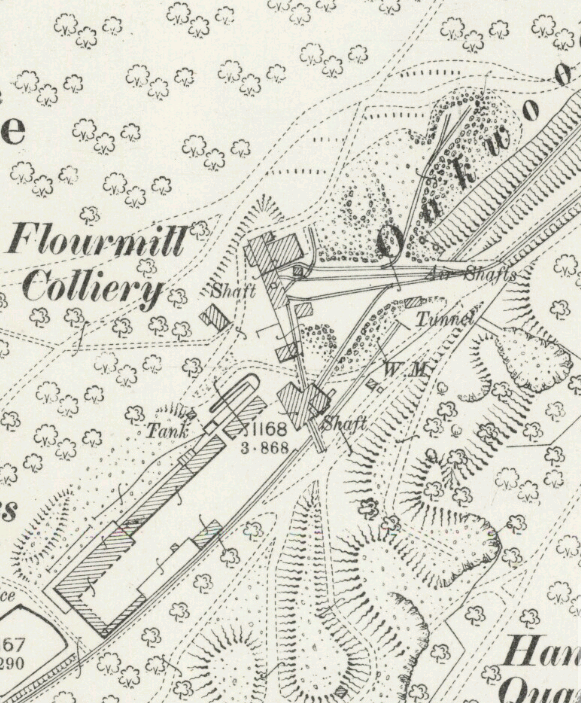
After about the turn of the century, the future of the Flour Mill Colliery became intricately tied to the future of the Princess Royal Colliery.
In 1855 Thomas Dyke took on the lease of the Princess Royal gale. It was stated that he had begun to drive a level into the upper coal measures of the Princess Royal gale seeking the Yorkley seam and he applied to the Crown for permission to build a tramroad from the level to the main line of the Severn & Wye at Tufts. That tramroad was extended to the Whitecroft to Bream road by his tenant, William Mullinger Higgins in 1856.
In 1876 the Severn & Wye extended their Oakwood branch along the course of Dyke’s tramway to Dyke’s Level, now also known as Whitecroft Level. In February 1887, Princess Royal, Flour Mill and Prince of Wales gales were in the hands of William Camm and Richard Watkins, both of Bream. The Princess Royal gale had been opened but was not being worked, Flour Mill was being worked to a limited extent whilst Prince of Wales was unopened. Watkins was hoping that the Crown would remove the barriers between the three gales and allow him to work them as one.
A rope incline tramroad operated between Flour Mill and Princess Royal collieries.
In 1890 new sidings on the Oakwood branch of the Severn and Wye were constructed alongside Park Gutter pits and the branch was extended. In 1897 further sidings were added at Park Gutter and again in 1902 when a weighing machine was installed.
In 1906 increasing traffic from Princess Royal made further extensions to the siding accommodation necessary. The loaded wagon road was extended to hold fifty vehicles, the screen roads were altered to provide an extra machine for weighing empties, and the wagon storage sidings were also lengthened to give a capacity of ninety-six. All of these alterations were completed in 1908.
Oakwood Tramway Beyond Flour Mill Colliery

For a time Flour Mill Colliery was the site of Oakwood Chemical Works as the plan above shows. The tramroad licence of 1855 extended the Oakwood tramway through to the China Engine (SMR 5629) and New China level iron mines, a distance to the west of the Flour Mill Colliery.
As the tramway left the site of the colliery it passed to the South East of the pond before turning west-northwest on the south side of Oakwood Corn Mill and travelling on to a series of branches in the Nixon area, serving China Engine pit (SMR 5629), Princess Louise pit (SMR 10812), Oakwood Foundry (SMR 9936) and a series of iron ore mines. The tramroad beyond the Foundry (SMR 10834) was removed by 1901, traffic continuing on the remaining section until 1907-8, the remaining track was removed before 1914.

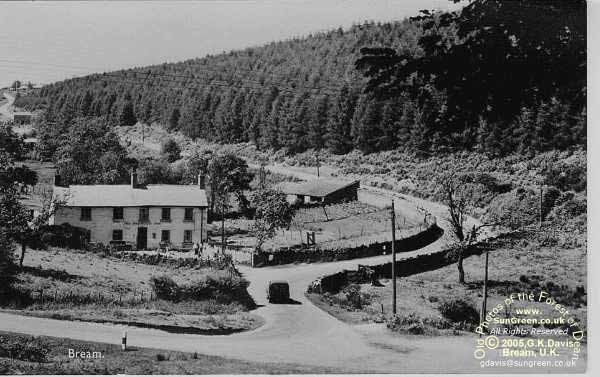
The picture shows the valley in the 1950s and is taken from the SunGreen website. The white building is Oakwood Mill Inn and the Foundry was sited off the left side of the picture. The Inn closed in 1969.
References
1. https://en.m.wikipedia.org/wiki/Parkend
2. https://en.m.wikipedia.org/wiki/Parkend_Ironworks
3. http://www.deanweb.info/parkend.html
4. http://www.theflourmill.com
5. Gloucester County Council Historic Environment Report Monument No. 5826.
6. Gloucester County Council Historic Environment Report Monument No. 15249.
7. http://lightmoor.co.uk/forestcoal/CoalFlourMill.html
8. http://lightmoor.co.uk/forestcoal/CoalPrincessRoyal.html
9. http://www.sungreen.co.uk/_Bream/MillHill1950s.htm

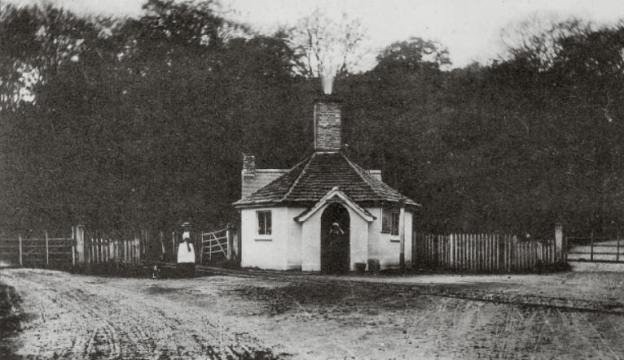








Pingback: The Forest of Dean – Bream Heritage Walk, the Oakwood Tramway and Flour Mill Colliery | Roger Farnworth